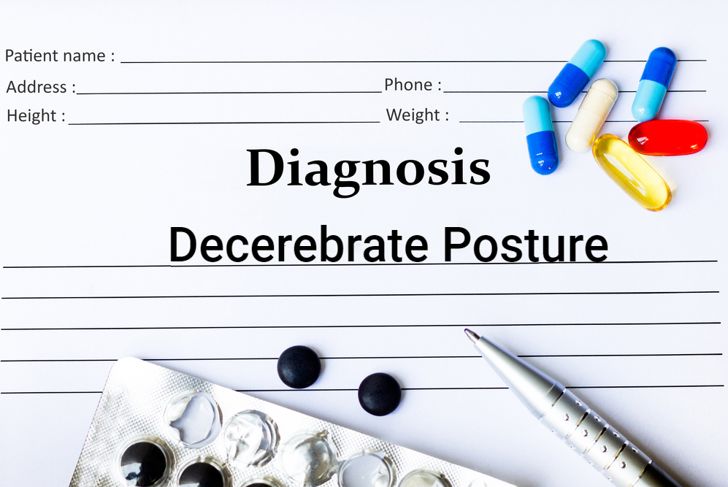Krabbe disease is one of a group of diseases called leukodystrophies that affect the brain, spinal cord, and nerves. It causes the degradation of myelin, the thin insulating layer around the nerves, which leads to the destruction of white matter. Krabbe disease is also associated with globoid cells — abnormal cells in the brain that are too large and have more than one nucleus.
Disease Process
Krabbe disease is caused by an enzyme deficiency that leads to improper metabolism of myelin. This deficiency causes lipids to build up, which has a toxic effect and prompts myelin-forming cells to self-destruct. Other cells have to work harder to eliminate the excess lipids and become abnormally large, promoting inflammation and causing further damage.
Infantile Krabbe Disease
Infantile Krabbe Disease has three stages. In the first stage, after developing normally until about four or six months, babies begin to develop symptoms such as irritability, difficulty feeding, and failure to thrive. They may also be hypersensitive to stimulation and spasm when exposed to bright light, noise, or touch. In stage two, the infant develops vision problems and begins to experience seizure-like episodes that do not respond to anti-convulsant medications. In stage three, the disease is debilitating, causing blindness, deafness, and severe spasticity.
Late Infantile and Juvenile Onset Krabbe Disease
In late infantile Krabbe disease, symptoms do not appear until between 13 and 36 months. At this time, the child may develop an abnormal gait, vision changes, and irritability, progressing to episodes of apnea, seizures, and difficulty regulating body temperature. In juvenile-onset Krabbe disease, early symptoms include tremors, gait disturbances, and ADHD. The rate of progression varies, but it is always debilitating.
Late-Onset Krabbe Disease
Late-onset Krabbe disease begins showing symptoms in late childhood or early adolescence. Symptoms start with burning numbness in the extremities, unsteady gait, seizures, hearing and vision loss, and spasticity. With this type, most young people deteriorate both mentally and physically, though some have physical symptoms only and remain mentally sound.
Inheritance
Krabbe disease is an autosomal recessive disease, which means that both parents must be carriers of the disease. Carriers usually do not have any symptoms of the disease and may not even know they are a carrier. When two carriers of an autosomal recessive disease like Krabbe disease have children, there is a one in four chance that the child will inherit the condition.
Diagnosis
Krabbe disease is diagnosed based on a review of symptoms and blood testing for the specific enzyme deficiency involved in the development of the disease. It is often confirmed with genetic testing. In some cases, the diagnosis comes after an abnormal newborn screen. Some obstetricians will do prenatal screening through amniocentesis when there is a history of Krabbe disease in the immediate family.
Treatment
For infants who have developed Krabbe disease, there is no treatment that can cure or improve the course of the disease. Treatment focuses on nutritional support, physical therapy, and medication to manage seizures, spasticity, and irritability. Older children or adults with Krabbe disease may benefit from physical therapy to minimize loss of muscle tone and occupational therapy to maintain as much independence as possible.
Hematopoietic Stem Cell Transplant
Additional therapeutic options are available for infants who are asymptomatic or have minimal symptoms. A hematopoietic stem cell transplant uses stem cells from a healthy donor to stimulate normal enzyme production in the brain. This treatment approach is most successful when done before symptoms appear, and studies show it can slow or stop the progression of symptoms. There are many risks with a stem cell transplant, including rejection and the extensive side effects of anti-rejection therapy.Some success has also been achieved by infusing cord blood stem cells from a donor, but only in patients who have not yet experienced symptoms.
Complications
Krabbe disease can lead to many serious complications, including deafness, blindness, spasticity, various infections, aspiration, respiratory failure, and early death. The disease commonly results in an abnormal posture called decerebrate posture, which often indicates severe brain damage. This type of positioning involves the arms and legs being straight and the head and neck arching backward.
Prognosis
People with infantile Krabbe disease have an average lifespan of 13 months and most die within two years of onset of the disease, though stem cell transplants may lengthen lives. Those with the juvenile-onset type usually die within two years of the onset of symptoms. For juvenile and late-onset, life expectancy is about ten years after onset.

 Home
Home Health
Health Diet & Nutrition
Diet & Nutrition Living Well
Living Well More
More




















